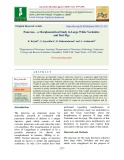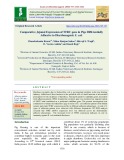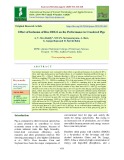
Desi pigs
-
The pancreas, an important organ of endocrine research is a digestive gland with both exocrine and endocrine functions. The pancreas for this study was collected from different age groups of large white Yorkshire and desi pigs. The morphometrical parameters such as weight of pancreas, length and width of each lobe and histometrical parameters such as number of islets per lobule, length and width of islets were recorded. The pancreas of pigs consisted of splenic, duodenal and connecting lobes. The mean weight of the pancreas was gradually increased as age advanced.
 5p
5p  gaocaolon5
gaocaolon5
 14-06-2020
14-06-2020
 9
9
 1
1
 Download
Download
-
Diarrhoea in piglets due to Escherichia coli is an important problem in the pig farming industry. Adhesion of these bacteria to the epithelial cells of small intestine is an essential prerequisite for the incidence of diarrhoea. Among the putative candidate genes associated with adhesion pattern, TFRC (transferrin receptor) gene was localized on targeted region of SSC13 and considered as a positional candidate gene. The present investigation was conducted to evaluate the Indian desi pigs in terms of E.
 6p
6p  nguaconbaynhay5
nguaconbaynhay5
 16-05-2020
16-05-2020
 8
8
 1
1
 Download
Download
-
The pancreas is a unique and composite digestive gland consisting of exocrine part of acini and endocrine part of islets of Langerhans. The pancreas were collected from five age groups viz., four, six, eight, ten months and adult in large white Yorkshire and also from adult desi pigs. Histochemical study revealed that the duct epithelium showed strong PAS reaction and weak reaction to acid mucopolysaccharides. Numerous tyrosine and lysine containing proteins were observed in the pancreatic parenchyma.
 4p
4p  nguaconbaynhay5
nguaconbaynhay5
 11-05-2020
11-05-2020
 9
9
 1
1
 Download
Download
-
Four dietary treatments were evaluated for their effect on growth performance of crossbred (LWY x Desi) male pigs during grower and finisher phases in a Completely Randomized Block Design. A Basal ration (T1) + 100g of Probiotic (Bacillus) + 500 g of enzyme cocktail per ton of feed, T1 + DDGS to contribute 20% of the total protein (9% & 7.5% of diet during grower and finisher phases, respectively (T2); T1 + DDGS to contribute 30% of the total protein (12.5% & 11% of diets during grower and finisher phases, respectively(T3); T1 + DDGS to contribute 40% of the total protein (16.
 10p
10p  caygaocaolon4
caygaocaolon4
 04-04-2020
04-04-2020
 13
13
 1
1
 Download
Download
CHỦ ĐỀ BẠN MUỐN TÌM

















